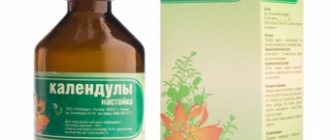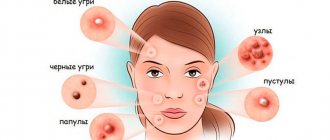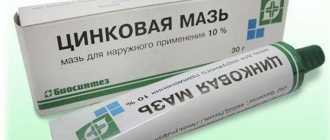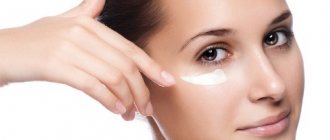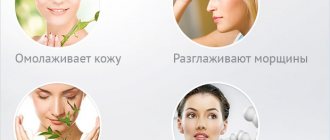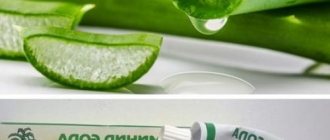Properties of Synthomycin ointment
Syntomycin is an ointment for acne, the main active ingredients of which are chloramphenicol and castor oil.
Chloramphenicol is a powerful antibiotic of synthetic origin. It disrupts protein synthesis in the microbial cell, which prevents its further reproduction and leads to death.
A special feature of the component is the low resistance of bacteria towards it. The antibiotic is highly effective against purulent acne and boils, due to its ability to penetrate deeply into tissues and have a therapeutic effect.
Castor oil has the following effects on problematic facial skin:
- moisturizes;
- relieves inflammation;
- has an antimicrobial effect;
- promotes tissue regeneration;
- reduces sebum production.
As auxiliary components, liniment contains sodium carboxymethylcellulose and purified water.
Additionally, the active components of liniment have a keratolytic effect, that is, they promote the exfoliation of dead epidermal cells, which often provoke blockage and inflammation in the dermis.
The drug does not help with spots and acne marks, but it helps prevent their appearance.
A little history
The name Sintomycin speaks for itself. The word has two roots: -synth-, indicating the synthetic origin of the substance, and -mits-, borrowed from the name of the producing microorganisms - the Actinomycetes Streptomyces venezuelae.
The compound was first isolated from culture fluid in 1947. Syntomycin substance is a racemate - a mixture of equivalent quantities of two spatial configurations (D and L) of one chemical compound, Chloramphenicol. Later, a levorotatory isomer was isolated from this mixture, which was given the logical name Levomycetin.
Indications for acne
Chloramphenicol has a wide spectrum of action and has a detrimental effect on bacteria that provoke the development of acne, furunculosis and carbuncles. It successfully neutralizes gram-positive and gram-negative microbes that cause inflammation in the skin. The active substance also promotes faster healing of affected tissues and relief of inflammation.
Thanks to these properties, the antibiotic is especially effective for severe forms of acne, which include acne conglobata, papulopustular rash and cystic acne.
Drug interactions
The simultaneous administration of antibiotics in tablets and injections can weaken the effect of Synthomycin liniment (penicillin, cephalosporins), and Nystatin or Levorin (antifungal agents) helps to enhance the effect. The following combinations are prohibited:
- erythromycin,
- lincomycin,
- sulfonamides,
- anticonvulsants,
- alcohol and alcohol tinctures.
All of them increase the toxicity of synthomycin and increase its adverse effects on hematopoiesis and the liver.
How to use Synthomycin ointment for acne?
Before using a topical antibiotic against acne, it is recommended to carefully study the information on use, as well as available contraindications.
The instructions recommend using the acne remedy in the following way:
- Apply directly to problem areas.
- Leave until completely absorbed.
- Apply morning and evening.
Before applying the ointment, it is recommended to cleanse the skin with cleansing gel and then allow the skin to dry on its own.
For boils and internal acne, Syntomycin is used as an application. On clean and dry skin, fix the bandage with the medicinal substance using a hypoallergenic patch and leave it overnight. The procedure is carried out until the purulent contents are opened and released.
Syntomycin ointment for acne on the face is used for 7-10 days. If there is no improvement, you should consult a doctor to change the drug.
When are candles needed?
Suppositories with Syntomycin are prescribed only for insertion into the vagina (placed as deep as possible) for the same indications as liniment:
- preparation for examination in gynecology (curettage, hysterography);
- installation of the spiral (3 days before and 4 days after installation);
- upcoming medical abortion;
- treatment of inflammation in the vulva, vagina, cervix.
Suppositories are administered depending on the purpose and doctor’s recommendations from 1 to 4 times a day, 1 piece each, and the course can be from 5 to 14 days.
Cautions
Sintomycin for acne on the face can be used only if there is no violation of the integrity of the epidermis. The antibiotic is applied exclusively to the inflamed areas, without affecting the healthy area.
Before using the product, you should be tested for the presence or absence of an allergic reaction. A small amount of the drug is applied to the skin in particularly sensitive places (the inner bend of the elbow, the wrist, the area behind the ear). If there is no burning or redness, an antibiotic can be used.
Synthomycin liniment for acne can be used only in the absence of contraindications and for therapeutic purposes. Chloramphenicol should not be used for prophylactic purposes.
Before using the product in the treatment of acne, it is recommended to consult a dermatologist and undergo an examination to identify the cause of the development of the skin disease.
Contraindications
Despite the fact that this drug is exclusively for external use, it is applied to open and treated wounds (under a bandage), and given the good penetration of Synthomycin into tissue, part of the substance may enter the systemic bloodstream.
Before use, please read the contraindications:
- Pregnancy and lactation;
- Neonatal period (up to 4 weeks);
- Fungal skin diseases, psoriasis, eczema;
- Individual intolerance, including to the components of the drug;
- Inhibition of hematopoiesis and any forms of anemia;
- Acute intermittent porphyria;
- Renal and/or liver failure;
- Glucose-6-phosphate dehydrogenase deficiency.
We have already written several times that in the presence of purulent discharge, it is absolutely not recommended to use drugs containing Chloramphenicol, especially with tissue repairers such as Methyluracil, since these drugs do not have osmotic activity and are unable to draw pus from the wound.
Before use, it is recommended to conduct an allergy test on the inside of the elbow or on the skin behind the ear.
Liniment is used with caution in children, patients with cardiovascular diseases and patients who have previously received cytostatics (due to inhibition of hematopoiesis).
Negative effects of Synthomycin
If allergies occur, the ointment can lead to multiple skin rashes and Quincke's edema.
In rare cases, external use causes a deterioration in hematopoietic function. The development of an adverse reaction occurs with prolonged therapy.
An antibiotic leads to the death of not only pathogenic, but also beneficial microorganisms, so its use for a period exceeding the recommended period contributes to the deterioration of the condition of the skin.
Precautionary measures
When treating with Synthomycin liniment, it is important to be careful; the following should not be allowed:
- contact with eyes;
- uncontrolled and unsystematic use (from case to case);
- self-medication;
- use for children without prescription and medical supervision;
- use immediately after a course of chemotherapy or radiation;
- simultaneous application with cosmetics;
- lubricating contaminated skin.
Analogs of Syntomycin ointment
The following products have a similar composition and principle of action that can be used against acne and acne:
- Levomecithin ointment;
- Levomekol;
- Levosin.
Levomecithin ointment contains chloramphenicol, which explains its use for acne. It is the drug of choice among acne treatments. It has a similar scheme of use in the treatment of purulent rashes.
In addition to chloramphenicol, Levomekol contains dioxomethyltetrahydropyrimidine, which acts as a stimulator for rapid tissue regeneration. The drug draws out the purulent contents of acne well and promotes rapid regeneration without the consequences of post-acne in the form of spots and scars.
Levosin is effective in the presence of painful rashes, due to its additional anesthetic effect. In addition to chloramphenicol, it contains methyluracil, which helps relieve inflammation and rapid regeneration, as well as trimecaine, which acts as an anesthetic.
Price for the drug
Synthomycin liniment 10% 25g can be bought at a price of 34-36 rubles, and produced by Nizhpharm for 65 rubles. Many patients note the effectiveness of the latter ointment. Suppositories of 250 mg, 10 pieces per package, cost about 48 rubles, they are bought with a doctor’s prescription (liniment is an over-the-counter drug).
We recommend reading about what ointments are used to heal wounds. From the article you will learn about the indications for the use of regenerating ointments, the best ointments for open and weeping wounds, with antibiotics. And here is more information about why and how Panthenol is used.
Synthomycin ointment (liniment) is used for burns, cracked nipples, pustular rashes, infectious skin diseases, to accelerate wound healing and prevent infection. When applied in large quantities it is toxic; blood composition needs to be monitored during treatment.
Synthomycin ointment for acne: reviews
Vera: At one time, Synthomycin helped me very well for acne. There were terrible purulent rashes on my face. Liniment made it possible to stop the inflammation and remove the pus. After healing, no marks remained on the skin.
Oleg: For a long time I suffered from internal red acne. The doctor advised me to try the liniment Sintomycin. Acne became less noticeable within three days after starting use. They did not go away completely, but there were much fewer of them.
Polina: Synthomycin ointment for acne did not work for me. A terrible allergic reaction began. I had to immediately stop the drug and consult a dermatologist, who advised replacing it with Differin.
Composition and release form
Synthomycin ointment is one of the effective means for treating acne; it is a drug with a bacteriostatic effect. It is a creamy mixture of milky white or yellowish color.
Let's take a closer look at the composition:
- Chloramphenicol (D, L) 10g;
- Castor oil (base) 20g;
- Emulsifier No1 (emulsifier) 3-5g;
- Sorbic acid (preservative) 0.2g;
- Carmellose sodium (polymer, prolongator) 1.84g;
- Purified water 100g.
Based on the composition, we see that the name ointment is incorrect, since the mixture of oil + emulsifier + water forms an emulsion, and the addition of a polymer stabilizes it and the result is a liniment. The ointment is based on solid fats. Therefore, the correct name is Syntomycin liniment .
The presence of antimicrobial activity is due to the first component - Chloramphenicol, or rather its racemic mixture, purified from toxic by-products. It is worth immediately noting that the racemic mixture has 50% of the activity of the most active isomer - Levomycetin, that is, the liniment in fact is not 10%, but 5%, but this is still better than Levomekol (0.75%) and Levosin (1 %).
The product can be found in dark glass jars of 20, 25 grams, aluminum tubes of 20, 25, 30, 40 grams with a screw cap, placed in a cardboard box along with instructions for medical use. It is sold in pharmacies without a prescription and is usually stored in the refrigerator.
